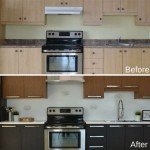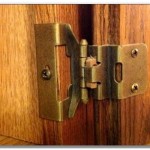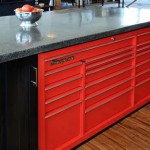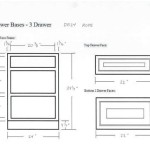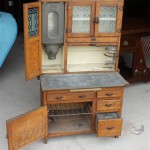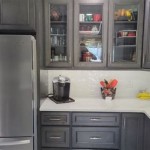Are Vinyl Wrap Kitchens Any Good? An In-Depth Look
Kitchen renovations often represent a significant investment for homeowners. A key aspect of any kitchen remodel is the cabinetry. Replacing existing cabinets can be exceedingly expensive, leading many to explore alternative, more cost-effective solutions. Vinyl wrap kitchens, also known as thermofoil kitchens, have emerged as a popular option. The question remains: are vinyl wrap kitchens any good? This article will provide an in-depth examination of vinyl wrap kitchens, detailing their advantages, disadvantages, and overall suitability for various homeowners.
Vinyl wrapping involves applying a thin layer of polyvinyl chloride (PVC) film, commonly referred to as vinyl, to a substrate, typically medium-density fiberboard (MDF). A specialized adhesive bonds the vinyl to the MDF under heat and pressure, creating a seamless, durable finish. The resulting surface offers a range of aesthetic possibilities, from solid colors and wood grains to textured finishes. The process allows for intricate detailing and edge profiles on cabinet doors and drawers, enhancing the overall design.
Advantages of Vinyl Wrap Kitchens
Several key advantages make vinyl wrap kitchens an attractive option for many homeowners. These benefits relate to cost-effectiveness, durability (to a certain extent), design versatility, and ease of maintenance.
Cost-Effectiveness: Compared to solid wood or professionally painted cabinets, vinyl wrap kitchens typically present a more affordable alternative. The materials themselves are less expensive, and the manufacturing process is often streamlined, reducing labor costs. This price advantage allows homeowners to allocate budget resources to other aspects of the kitchen renovation, such as appliances or countertops.
Design Versatility: Vinyl wraps come in a vast array of colors, patterns, and finishes. This enables homeowners to achieve virtually any desired aesthetic, from contemporary high-gloss to traditional wood-grain looks. The ability to mimic the appearance of more expensive materials, such as natural wood or painted surfaces, provides design flexibility without the associated financial burden. Furthermore, vinyl wraps can be applied to various cabinet door styles, including flat-panel, shaker, and raised-panel designs, further increasing design options.
Ease of Maintenance: The smooth, non-porous surface of vinyl wrap cabinets makes them exceptionally easy to clean. A simple wipe with a damp cloth and mild detergent is usually sufficient to remove spills, stains, and everyday grime. This low-maintenance characteristic is particularly appealing for busy households where time is a premium. The resistance to staining also ensures that the cabinets maintain their appearance over time, reducing the need for frequent cleaning or refinishing.
Seamless Finish: The vinyl wrapping process creates a seamless, smooth finish that eliminates visible seams or joints on cabinet doors and drawer fronts. This enhances the aesthetic appeal of the kitchen and also prevents the accumulation of dirt and moisture in crevices. The seamless finish contributes to the overall durability and longevity of the cabinets by minimizing potential points of weakness.
Disadvantages of Vinyl Wrap Kitchens
Despite their advantages, vinyl wrap kitchens also have limitations that homeowners should carefully consider. These drawbacks primarily relate to heat resistance, potential for peeling, repair complexities, and environmental concerns.
Heat Sensitivity: Vinyl wrap is susceptible to damage from prolonged exposure to high heat. Cabinets located near ovens, stovetops, or dishwashers are particularly vulnerable. Excessive heat can cause the vinyl to blister, peel, or delaminate from the underlying MDF substrate. To mitigate this risk, it is crucial to ensure adequate ventilation around heat-generating appliances and to use heat shields or protective barriers where necessary. Avoid placing heat producing appliances directly under vinyl wrapped cabinets.
Potential for Peeling: While the adhesive used to bond vinyl wrap to MDF is generally strong, the edges and corners of cabinet doors and drawers are susceptible to peeling, especially in high-use areas. Moisture, cleaning chemicals, and physical impacts can compromise the adhesive bond over time, leading to delamination. Once peeling begins, it can be challenging to repair and may necessitate replacement of the affected cabinet components.
Repair Complexities: Repairing damaged vinyl wrap is often a complex and challenging task. Minor scratches or dents may be repairable with specialized fillers or touch-up kits, but more extensive damage, such as peeling or blistering, typically requires professional intervention. Matching the existing vinyl color and pattern can also be difficult, potentially resulting in visible repairs. In many cases, replacing the entire cabinet door or drawer front is the most practical solution, which can add to the overall cost of ownership.
Environmental Concerns: The production and disposal of PVC vinyl raise environmental concerns. PVC is a petroleum-based plastic that relies on non-renewable resources. The manufacturing process can release harmful chemicals into the environment, and the incineration of PVC waste can generate dioxins, which are known carcinogens. While recycling options for vinyl are improving, they are not yet as widely available as those for other materials, such as wood or metal. Homeowners conscious of their environmental impact may want to explore alternative cabinet materials with more sustainable production and disposal practices.
Factors Influencing the Longevity of Vinyl Wrap Kitchens
The lifespan of a vinyl wrap kitchen is significantly influenced by several factors, including the quality of materials and installation, the level of care and maintenance provided, and the overall kitchen environment.
Material and Installation Quality: The quality of the vinyl wrap and the MDF substrate used in cabinet construction directly impacts the durability and longevity of the kitchen. High-quality vinyl wraps are more resistant to heat, moisture, and scratches, while durable MDF provides a stable and robust base for the vinyl to adhere to. Proper installation is equally crucial. Experienced installers will ensure that the vinyl is applied smoothly and evenly, with attention to detail around edges and corners, minimizing the risk of peeling or delamination.
Care and Maintenance: Regular cleaning and proper care can significantly extend the life of vinyl wrap cabinets. Avoid using abrasive cleaners or harsh chemicals that can damage the vinyl surface. Wipe up spills promptly to prevent staining and avoid placing hot items directly on the cabinets. Periodically inspect the edges and corners for signs of peeling and address any issues promptly to prevent further damage. Implementing these preventative measures will contribute to the long-term performance and appearance of the kitchen.
Kitchen Environment: The environmental conditions within the kitchen can also affect the lifespan of vinyl wrap cabinets. High humidity levels, excessive heat, and exposure to direct sunlight can accelerate the deterioration of the vinyl. Proper ventilation and climate control can help mitigate these risks. Consider using exhaust fans when cooking to reduce humidity and heat buildup. Install blinds or curtains to shield the cabinets from direct sunlight. By controlling the kitchen environment, homeowners can help preserve the integrity of their vinyl wrap cabinets.
In conclusion, the suitability of vinyl wrap kitchens depends on individual priorities, lifestyle, and budget. While offering cost-effectiveness, design versatility, and ease of maintenance, the limitations regarding heat resistance, potential for peeling, and repair complexities must be considered. Homeowners should weigh these factors carefully before making a decision. Understanding the advantages and disadvantages, along with the factors affecting longevity, will empower homeowners to make an informed choice about whether a vinyl wrap kitchen is the right fit for their needs and circumstances.

Are Vinyl Wrap Kitchens Any Good Wespray

Is It Better To Paint Or Vinyl Wrap Kitchen Cupboards

Spray Paint Or Vinyl Wrap For Kitchen Cupboards Upvc Painting

Vinyl Wrap For Kitchen Cupboard Doors Restoration

Vinyl Wrap For Kitchen Cupboard Doors Restoration

How Much Does Kitchen Door Wrapping Cost In 2024 Checkatrade

Can Kitchen Vinyl Wrap Problems Be Fixed Wespray

Kitchen And Furniture Wrapping Chromatic Vinyl S Ltd T A Wrap Direct

Pros And Cons Of Vinyl Wrap Kitchen Doors The Door Company

Vinyl Wrap Vs Two Pack Kitchen Cabinets Which Is Better
Related Posts


